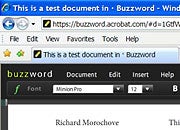Today Adobe launched the free public beta version of Acrobat.com,
a Web-based supplement to its popular PDF document creation
application. The new site offers an array of services to help
businesses share and collaborate on documents. It also supports basic
Web conferencing (including desktop sharing) and limited free
conversion of documents to PDF format.
Acrobat.com works well
with the beta version of Acrobat 9 (also announced today), which
includes menus for sharing and collaborating on documents. (See our
First Look, "Acrobat 9 Aims to Reinvent PDFs"). The final version of Acrobat 9 is scheduled to ship in July, along with a new version of Adobe Reader.
But
even if you don't use Adobe's desktop apps, you can get a lot of
mileage from Acrobat.com if you work with others to create documents. I
was able to test most of the beta Acrobat.com features last week, and
found them to be an excellent mix of services for remote collaboration.
Acrobat.com
has four principal components: a word processor called Buzzword; online
file sharing via a feature called Share; a file converter that lets you
convert up to five documents per month, free, to PDF format (offered
within Share); and ConnectNow for personal Web conferencing. Adobe also
makes APIs available for developers so they can create service mash-ups
more easily.
Word Processing
Buzzword, a Flash-based word processor, was originally developed by Virtual Ubiquity, which Adobe acquired last
September. The program is no Microsoft Word, but it covers the basics
of document creation, including formatting, tables, and image
importing. Its menus are easy to learn and its response time is quick.
Buzzword
shines when you need to share or collaboratively create documents. You
can decide whether to share a document with anyone who knows its URL or
to restrict access to specific Acrobat.com users. User rights--which
the person who submits the document to Acrobat.com assigns--range from
Co-author (full document-editing privileges) to Reviewer (may add
comments only) to Reader (may read only).
Each collaborator's
comments appear in a different color. Buzzword saves the document
automatically as you work. You may revert to an earlier version if you
wish.
You can import and export Buzzword documents to other
popular document formats including Word (.doc, .docx, .xml), .rtf, and
.txt. You can also export to HTML or to PDF formats.
Document Sharing
Share
assigns a unique URL to each document that you upload to your account
(you get 5GB of storage space). To share a document, you enter the
other person's e-mail address, along with an optional message, and
specify whether the file may be viewed publicly or only by the
recipient. The recipient will receive an e-mail with a link to the
document.
You can embed public documents on a Web site or
blog. Readers will see a small thumbnail; they can click this to see a
PDF document or image file in a full-screen preview.
You
can share files, including Office documents, in non-Adobe formats. But
within the browser you can view only Adobe documents; to view all
others, you must run a desktop application that supports the file
format.
PDF Form Sharing and Conversion
Acrobat.com
offers an interesting-sounding PDF form-sharing and tabulation service,
too; but because it requires Acrobat 9 (which wasn't available for
testing prior to the site's launch), I couldn't try it out. However,
Adobe presented a demo of how the feature could be used to distribute a
PDF form (for conference registration, say) by e-mail.
Recipients
would be instructed to complete the form and send it to Acrobat.com,
which would notify the original sender when completed forms arrived and
would tabulate the results in a simple database. The sender could then
view the results, broken down by categories such as which recipients
had registered for which conference session.
This could be a valuable service for a small business that currently has to set up its own server to handle form tabulation.
Acrobat.com
also lets you add comments to PDF documents. Since Acrobat 9 supports
more file types--including video conversion to FLV--you can mark up and
discuss video changes if you have the desktop app.
Web Conferencing
Adobe's ConnectNow Web conferencing service
for individuals and small businesses supports up to three conference
participants. Presumably this rather low user limit is intended as an
inducement for businesses to upgrade to Adobe's Connect Pro.
ConnectNow
lets you can share your computer desktop and collaborate on a document
in real time. You may also take meeting notes in a notes pod, exchange
text chat messages, or communicate via audio. Adobe provides
teleconferencing numbers that use the Vapps voice conferencing service, but
users must pay all toll charges. The conferencing service is similar to those offered by several competitors, including Cisco's WebEx.
Desktop Software Helpful but Not Required
Most
of Acrobat.com's services don't require you to buy Adobe apps. You can
sign up and use the site independently or with the free Adobe Reader 9
once it is released. You will need Acrobat 9 to take advantage of some
of Acrobat.com's good capabilities, however, such as the ability to
create forms and to create and embed video in PDFs for annotation.
After
the beta test period ends (Adobe hasn't specified a date for this), the
company will charge a fee (not yet determined) for a premium
Acrobat.com service that will offer greater storage capacity and
as-yet-unidentified additional capabilities. A basic version of the
service will remain free.
I was particularly impressed by
Acrobat.com's document collaboration capabilities, which are superior
to those offered by other online services, such as Google Docs. If you often need to work with others to create documents, I recommend that you try Adobe's new service.
